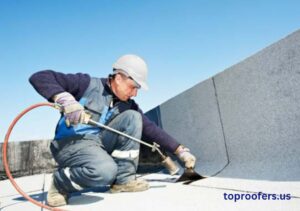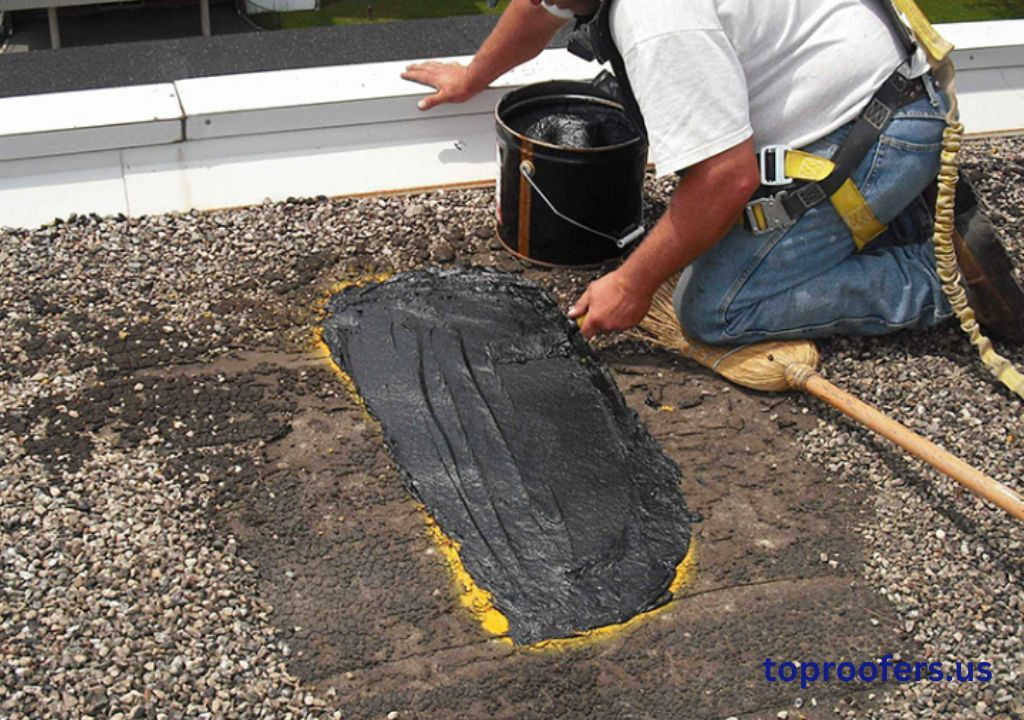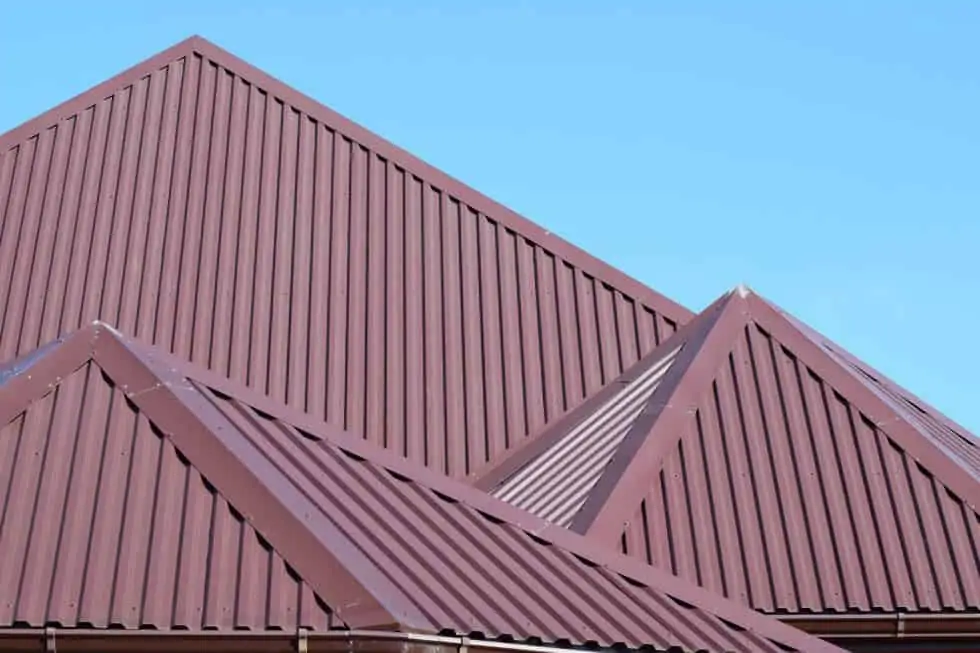Fixing a commercial roof involves identifying the issue and implementing the appropriate repair solution. This ensures the roof’s integrity and longevity.
Commercial roof maintenance is crucial for any business. A well-maintained roof protects against leaks, energy loss, and structural damage. Regular inspections and prompt repairs can save significant costs in the long term. Identifying issues early, such as cracks, punctures, or water damage, helps in quick resolution.
Different roofing materials may require specific repair techniques. Hiring professional roofing services ensures the job is done correctly and safely. Investing in quality repairs enhances the roof’s lifespan and the building’s overall safety. Proper commercial roof care protects your investment and ensures business operations run smoothly without interruptions due to roofing problems.

Common Roof Issues
Commercial roofs these problems can save you money and prevent face a variety of challenges and problems. Knowing common roof issues can help you maintain your roof better. Fixinnt further damage. Let’s delve into some of the most frequent issues commercial roofs encounter.
Leaks And Water Damage
LeMold growth – Mold can thrive in damp conditions, posing health risks.
- Structural damage – Water can weaken the building’s structure.
- Interior damage – Leaves and water damage are the most common issues with commercial roofs. Water can seep through small cracks and cause significant damage over time. This can lead to:
- ks can ruin ceilings, walls, and equipment.
Regular inspections are essential to catch leaks early. Look for:
- Water stains on the ceiling
- Damp spots on walls
- Pooling water on the roof
Addressing leaks promptly can prevent extensive damage. Consider using waterproof coatings and ensuring proper drainage to mitigate water damage risks.
Punctures And Tears
Punctures and tears can occur from various sources. Foot traffic, falling debris, and extreme weather can all contribute. These issues can compromise the roof’s integrity. Key points include:
- Foot traffic – Maintenance workers may cause punctures.
- Falling debris – Tree branches and other debris can tear the roof.
- Severe weather – Hail and strong winds can create punctures.
Preventing punctures and tears involves:
- Using walkway pads to protect the roof surface
- Trimming overhanging branches
- Inspecting the roof after storms
Quick repairs are vital. Use roofing patches and sealants to fix punctures and tears immediately.
Poor Insulation
Poor insulation can lead to various problems for commercial roofs. It can affect energy efficiency and indoor comfort. Key signs of poor insulation include:
- High energy bills – Poor insulation makes heating and cooling systems work harder.
- Uneven temperatures – Inconsistent indoor temperatures can indicate insulation issues.
- Ice dams – In colder climates, poor insulation can cause ice dams on the roof.
Improving insulation involves:
| Action | Benefit |
| Adding insulation layers | Improves energy efficiency |
| Sealing gaps and cracks | Prevents air leaks |
| Using reflective coatings | Reduces heat absorption |
Proper insulation can save money and enhance comfort. Regular checks can help maintain insulation effectiveness.
Signs You Need Repairs
As a business owner, maintaining your commercial roof is crucial. Ignoring signs of damage can lead to costly repairs and interruptions. Identifying the signs you need repairs early can save you time and money. Below are key indicators that your commercial roof may need attention.
Visible Damage
Visible damage to your roof is a clear sign that repairs are needed. Look for cracks, holes, and missing shingles. These issues can lead to leaks and structural damage if not addressed promptly.
Here are some common visible signs that we need to consider:
- Cracked or missing shingles: These allow water to penetrate your roof.
- Warped or bent flashing: This can cause leaks around vents and chimneys.
- Ponding water: Pools of water on a flat roof can lead to leaks and structural issues.
A quick inspection can help identify these problems. Use a table to keep track of any visible damage:
| Type of Damage | Location | Severity |
| Cracked Shingles | North Side | Moderate |
| Warped Flashing | Vent Area | Severe |
| Ponding Water | Center of Roof | High |
Increased Energy Bills
If you notice a sudden spike in your energy bills, your roof might be the culprit. A damaged roof can let in cold air during winter and hot air during summer, causing your HVAC system to work harder.
Signs your roof is affecting your energy bills include:
- Higher heating costs in winter: Drafts can enter through damaged roofing areas.
- Increased cooling costs in summer: Hot air can seep in, requiring more air conditioning.
- Uneven temperatures in different areas: This indicates poor insulation or ventilation.
To help manage energy costs, perform regular roof inspections, and address any issues promptly. Here’s a simple checklist:
- Inspect for visible damage.
- Check insulation levels.
- Ensure proper ventilation.
- Repair or replace damaged areas.
Mold Growth
Mold growth on your roof or inside your building is a serious concern. Moisture trapped by a damaged roof can lead to mold, which poses health risks and damages property.
Indicators of mold growth include:
- Musty odors: Mold often produces a distinct smell.
- Visible mold spots: Check ceilings and walls for discoloration.
- Health symptoms: Employees may experience allergies or respiratory issues.
To prevent mold, ensure your roof is well-maintained. Regularly check for leaks and repair any damages immediately. Use a table to track mold inspection findings:
| Area Inspected | Signs of Mold | Action Required |
| Ceiling Tiles | Discoloration | Replace Tiles |
| Wall Corners | Musty Smell | Inspect for Leaks |
| Roof Interior | Visible Mold | Professional Cleaning |
Choosing The Right Repair Method and Fix commercial roof
Maintaining a commercial roof is essential to protect your investment. Choosing the right repair method can extend the roof’s lifespan and save money. This decision involves evaluating the damage, selecting materials, and considering costs. Let’s explore the key factors to guide you through this process.
Patch Vs. Replace
Deciding whether to patch or replace your commercial roof depends on the extent of the damage. Patching is ideal for minor issues like small leaks or isolated damage. It’s a quick fix that can extend the roof’s life without a significant investment.
- Patch: Suitable for minor leaks, small cracks, and isolated damage.
- Replace: Needed for extensive damage, widespread leaks, or structural issues.
Replacement becomes necessary when the roof has severe damage or is nearing the end of its lifespan. Here are some factors to consider:
| Factor | Patch | Replace |
| Extent of Damage | Minor/Isolated | Severe/Widespread |
| Cost | Lower | Higher |
| Time | Quick Fix | Time-Consuming |
| Longevity | Temporary | Long-Term |
Evaluate these factors carefully to make an informed decision. Patch repairs are cost-effective but may not address underlying issues. Replacement, while more expensive, ensures long-term stability.
Material Selection
Choosing the right materials for your roof repair is crucial. The material impacts the roof’s durability, energy efficiency, and cost. Here are some popular options:
- EPDM (Ethylene Propylene Diene Monomer): Known for durability and weather resistance. Suitable for various climates.
- TPO (Thermoplastic Olefin): Offers energy efficiency and is eco-friendly. Ideal for buildings aiming to reduce energy costs.
- PVC (Polyvinyl Chloride): Excellent for chemical resistance and long-lasting performance. Perfect for industrial buildings.
- Metal Roofing: Highly durable and low maintenance. Provides excellent protection against extreme weather.
When selecting materials, consider the building’s location, climate, and purpose. For instance, TPO is excellent for energy savings, while EPDM offers weather resistance. PVC suits industrial sites due to its chemical resistance.
A comparison table to help decide:
| Material | Durability | Cost | Benefits |
| EPDM | High | Moderate | Weather Resistant |
| TPO | Moderate | Low | Energy Efficient |
| PVC | High | High | Chemical Resistant |
| Metal | Very High | Variable | Low Maintenance |
Cost Considerations
Cost considerations play a significant role in deciding your repair method. Budget constraints and long-term savings must be balanced. Here are some points to consider:
- Initial Costs: Patching is a cheaper way to initially than a full replacement.
- Long-Term Costs: Replacement may offer better long-term savings by reducing frequent repairs.
- Energy Efficiency: Investing in energy-efficient materials can lower utility bills.
- Maintenance Costs: Some materials like metal require less maintenance, reducing long-term costs.
Here’s a comparison of costs:
| Repair Method | Initial Cost | Long-Term Cost | Energy Savings |
| Patch | Low | High (frequent repairs) | Low |
| Replace | High | Low (less frequent repairs) | Variable (depends on material) |
Balancing these costs helps in making the best decision. Patching is budget-friendly but might incur higher costs over time. Replacement demands higher initial investment but offers stability and potential savings.

Diy Vs. Professional Help
Fixing a commercial roof can be a daunting task. Deciding between DIY and professional help is crucial. Both options have pros and cons. Understanding them can save time, money, and headaches. This guide will help you make an informed.
When To Diy
DIY roofing can be tempting for small issues. You can save money and learn new skills. Simple repairs like patching small leaks or replacing a few shingles are manageable. Here are some situations where DIY can be suitable:
- Minor leaks: If the leak is small and easily accessible.
- Loose or missing shingles: Replacing a few shingles doesn’t require much skill.
- Gutter cleaning: Regular cleaning prevents water damage.
Make sure you have the right tools:
| Tool | Purpose |
| Hammer | Nailing shingles |
| Utility Knife | Cutting materials |
| Sealant | Fixing leaks |
Always check the weather before starting. Never work on the roof during bad weather. Also, wear proper safety gear like gloves and non-slip shoes. DIY can be rewarding but requires caution and preparation.
Benefits Of Hiring Experts
Hiring professional roofers offers many benefits. Expertise and experience ensure quality work. Here are some key advantages:
- Professional assessment: Experts can identify underlying issues.
- High-quality materials: They have access to better materials.
- Time-saving: Professionals complete the job faster.
- Warranty: Most companies offer guarantees on their work.
Consider these factors when hiring:
| Factor | Importance |
| Experience | Ensures they know what they’re doing |
| Reputation | Check reviews and references |
| Cost | Get multiple quotes |
Hiring experts can prevent costly mistakes. They also handle permits and regulations. This ensures the job meets all legal requirements. Ultimately, professional help provides peace of mind.
Safety Considerations
Safety is a top priority when fixing a roof. DIY projects can be dangerous. Consider these safety tips:
- Proper gear: Wear helmets, gloves, and non-slip shoes.
- Stable ladder: Ensure your ladder is secure.
- Weather check: Avoid working in bad weather.
- First aid: Keep a first aid kit nearby.
Professional roofers follow strict safety protocols. They have training and equipment to handle risks. Here are some professional safety measures:
| Measure | Benefit |
| Harnesses | Prevents falls |
| Scaffolding | Provides a stable platform |
| Teamwork | Ensures help is available |
Consider the risks involved in DIY roofing. Falls and injuries can be serious. Hiring professionals ensures the job is done safely and correctly. This minimizes hazards and provides a safer environment.
Maintenance Tips fix the commercial roof
Maintaining a commercial roof is essential for the longevity of your building. Regular upkeep can prevent costly repairs and extend the life of the roof. Here are some crucial maintenance tips to keep your commercial roof in top shape.
Regular Inspections
Regular inspections are vital for identifying potential issues early. Schedule inspections at least twice a year to catch problems before they worsen. A thorough inspection involves:
- Checking for cracks or splits in the roofing material.
- Inspecting for water stains on the ceiling, which indicate leaks.
- Examining flashing for signs of rust or gaps.
- Looking for any debris that could cause damage.
Use a professional roof inspector for accurate assessments. They have the tools and expertise to spot hidden problems. A sample inspection checklist might include:
| Inspection Point | What to Look For |
| Roof Surface | Cracks, Blisters, Punctures |
| Flashing | Rust, Gaps, Loose Sections |
| Interior Ceiling | Water Stains, Mold |
Cleaning Gutters
Clean gutters prevent water damage and ensure proper drainage. Clogged gutters can cause water to back up, leading to leaks and roof damage. Follow these steps for effective gutter cleaning:
- Remove debris such as leaves and twigs by hand or with a scoop.
- Use a hose to flush out any remaining dirt.
- Check for any signs of rust or damage.
- Ensure downspouts are clear and directing water away from the building.
Perform gutter cleaning at least twice a year, ideally in spring and fall. Consider installing gutter guards to reduce the frequency of cleaning. A clean gutter system protects the roof and the building’s foundation.
Seasonal Checkups
Seasonal checkups prepare your roof for varying weather conditions. Each season poses different challenges:
- Spring: Inspect for damage from winter storms, and check for mold growth.
- Summer: Ensure the roof can handle high temperatures, and look for UV damage.
- Fall: Clear debris from falling leaves, and prepare for heavy rain and wind.
- Winter: Check for ice dams, and ensure proper insulation to prevent freezing.
A seasonal checklist helps maintain the roof’s integrity throughout the year. Consider these tasks:
| Season | Maintenance Task |
| Spring | Check for winter damage, clean gutters |
| Summer | Inspect for UV damage, and ensure proper ventilation |
| Fall | Clear leaves, inspect for leaks |
| Winter | Check for ice dams, ensure insulation |
Seasonal checkups ensure your roof remains in good condition, regardless of the weather. Regular maintenance helps avoid expensive repairs and extends the life of your commercial roof.
Credit: temaroofingservices.com
Frequently Asked Questions
What Is The Life Expectancy Of A Commercial Roof?
The life expectancy of a commercial roof ranges from 20 to 50 years. Factors like material, installation, and maintenance impact longevity. Regular inspections and repairs can extend its lifespan.
Can You Repair Just A Section Of A Roof?
Yes, you can repair just a section of a roof. It’s a cost-effective option for localized damage. Ensure the repair matches the existing roof to maintain its integrity and appearance. Always hire a professional for the best results.
Can Roof Damage Be Repaired?
Yes, roof damage can be repaired. Prompt repairs prevent further issues. Always consult a professional for accurate assessment and quality repair work.
How Do You Maintain A Commercial Roof?
Maintain a commercial roof by scheduling regular inspections, cleaning gutters, repairing damages promptly, ensuring proper drainage, and applying protective coatings.
How To Identify Commercial Roof Damage?
Look for leaks, cracks, and water stains. Check for loose or missing materials. Regular inspections help spot issues early.
Conclusion
Fixing a commercial roof ensures long-term durability and safety. Regular maintenance can prevent costly repairs. Choose a professional roofing service to handle complex issues. Investing in quality materials and expert care will protect your property. Stay proactive and keep your commercial roof in top condition.

